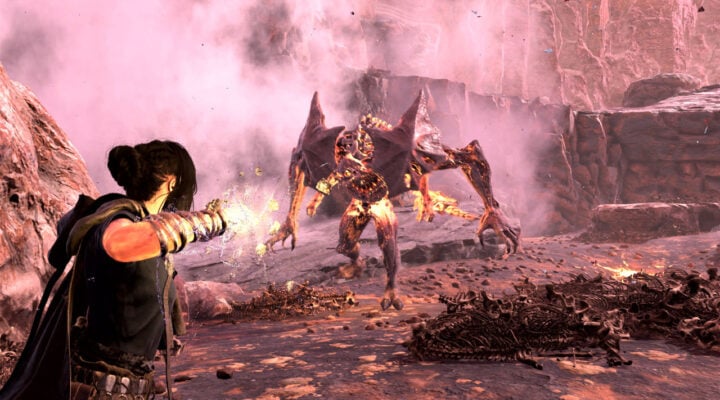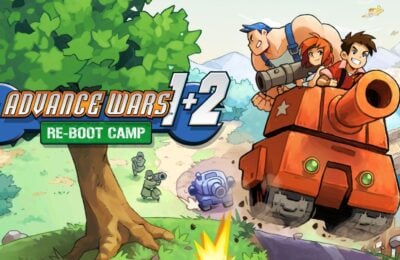I’m just going to come out and say it: I like Forspoken. Quite a lot, actually. In fact, it’s offered me some of the most fun I’ve had in a AAA release in some time. But then I am one of those irritating contrarians who’s drawn towards polarised games like a moth to a flame.
I promise I’ll actually move onto the point of this review shortly, but Forspoken has triggered a bit of introspection in me. Why do I typically love these much-maligned experiences far more than your superbly-polished Horizons and God of Wars? Well, I think it boils down to this: I like games that aren’t afraid to take risks and do something a little different. Or, maybe I just like to champion the underdog.
But what I do know for sure is that I really enjoy Forspoken. So much so that I’ve been taking my time with it, exploring every nook and cranny – both literally, in terms of exploring the world, and less literally, in terms of seeking out new spells and upgrading them just to see what happens.
I also get an almost Diablo-like fix from the loot system. Not only do I love discovering what a new robe will look like visually, but the perks often open up new build possibilities, completely altering how I approach combat.
What Is Forspoken?
But before we get into the depth of the experience, here’s what it is: it’s a brand new IP by Square Enix. Well, more specifically, Luminous Productions – a relatively new team that’s made up of much of the same team that built the equally-polarising Final Fantasy XV.
In fact, both games share a fair bit of DNA. Both were built in the Luminous Engine, feature an open-world full of sweeping vistas and biomes, and an action-focused combat system that involves swapping between a variety of spells/weapons. They also both feature irritating-at-first characters that grow on you over time.
The main point of differentiation between the two, though, is that Forspoken is a largely solitary experience, compared to FFXV’s focus on team building and camaraderie, and it features a totally different method of traversal. Out goes the beloved car for magic parkour. Yes, you read that correctly.
What’s Forspoken About?
You play as Alfre Holland (Frey for short), an initially frustrating young woman who lives a challenging life on the streets of New York. After a cheesy opening segment that sees you in court, then running away from some street hooligans, you find yourself in the fantasy world of Athia, where you encounter a dragon, learn magic, and get captured by the locals in quick succession.
That magic comes courtesy of your new talking bracelet, Cuff, who would find a comfortable home in the world of Fable. Some of you might find this English gentleman (gentlebracelet?) irritating, but I find him quite endearing, and the perfect counterpoint to Frey’s brusqueness.
You see, Frey’s not very endearing at first – all swear words and cocky swagger. I found her particularly frustrating when she was talking to some ye olde types in Athia’s main hub city of Cipal. She made zero effort to adapt her language. How is it that these medieval types are going to understand your modern-day lingo, Frey? Come on, use your head!
But she’s also a 20 year old woman who’s lived a tough life and has learned to adapt by just being a bit grumpy and impatient with those around her. I can respect that. Besides, her character does develop over the course of the adventure, and I did find myself rooting for her and Cuff long before the credits rolled.
You see, she’s quite quickly sent on an adventure to save the world – this is practically a JRPG after all. Why? Well, Frey can use magic, for one (courtesy of Cuff), and she’s also immune to the effects of “the break”, a post-apocalyptic event that sends all people and animals that encounter it pretty loopy.
That also includes the Tantas – a group of female magic users who govern the lands – who are acting completely out of character and making life generally miserable for the few inhabitants that remain. So, off you trot to defeat them and absorb their powers.
How Does Forspoken Play?
The core gameplay loop involves you exploring the four different regions of Athia, using your magic parkour to get about. As you progress, you’ll unlock new spells and abilities that make progression a lot faster – as well as more enjoyable.
Much like in Spider-Man, traversal is an absolute joy in Forspoken, and easily the highlight of the experience. When you break it down, it’s pretty simple: hold circle and pick a direction and Frey will run, jump, or climb with the grace of a superhero. When you get into a nice flow, it looks and feels amazing, and you’ll probably want to skip fast travel entirely.
Combat is similarly flashy and fun. You use magic parkour to dodge attacks, and return a barrage of your own with an absolute ton of spells. There are four schools in Forspoken, and each has its own basic, support, and surge spells. Basic are your bread and butter of combat, support are traditional spells that might help you close the gap, reduce damage, or heal, while surge are your special attacks.
With the sheer number of spells on offer, I expected combat to prove quite fiddly – almost like an MMO that had been adapted for a controller. But that hasn’t been the case at all. Swapping spells, or schools, slows down time (you can even force it to stop time completely in the settings), allowing you to take a breather to think while in the midst of combat.
Once you’ve figured out what each spell does, you’ll just find yourself getting into a flow state, using the spells that work best in the moment. When it’s at its most intense, with you dodging, popping off a quick attack spell, and throwing down some support options, it feels like a Platinum game. The score system compliments that, of course.
Are There Loads of Spells?
I’d also just like to comment generally on the pacing of the system. The amount of spells available in the game could easily have put me off, as I tend to prefer simplicity over complexity. However, the steady pace with which you unlock new spells helps you to get to grips with what they do. By the time you’ve mastered one, you’ll unlock a new toy to play with.
It also helps that you can complete an optional challenge for every spell in the game, which reminded me of a simplified version of the Hunting Ground Challenges in Horizon. These encourage you to use the spells in the manner with which the developer intended, helping you to master them. I felt very stupid for not using Disperse, a spell that puts down a turret-like plant, against flying enemies before the game advised me to.
The sheer volume of spell types, the steady pace with which they’re unlocked, and their application both in and out of combat makes discovery an absolute joy. I can’t remember the last time I played a game that had me deliberately seeking out new abilities to try. Not only is it deeply compelling, but it helps keep the experience fresh throughout its runtime.
How Long Is Forspoken?
That length can deeply vary depending on how you choose to play it. Run straight through the plot, and you can finish Forspoken in as little as 15-20 hours. However, I’d spent that much time with it when I beat the first Tantra and left Praenost 100% finished. So, how long you spend playing Forspoken can wildly vary. There’s easily a 60-80 hour adventure in there, if you’re someone that likes to do everything.
And, just to really emphasise the point, Forspoken is an experience at its most rewarding when you stop to smell the roses.
You see, it’s open world is very Assassin’s Creed-like. You stop at ‘Belfries’ to unlock POIs on your map, and run between them with wild abandon, unlocking new gear, spells, and stat upgrades as you go.
While this can be a chore in similar games, it’s a joy here thanks to that magic parkour. Not only that, but you can typically see everything an area has to offer in 20-30 mins, which is thanks in most part to an incredible world map.
It’s delivered in actual 3D, so you can see what the terrain looks like before you head to a POI. This lets you map out the best route from A to B, working your way from high to low terrain for example. Not only that, but you can mark up to five POIs at once, and order them, allowing you to get on a train of discovery. It’s wonderful attention to detail that’s going to put similar experiences to shame the next time I play an open worlder.
How Is It From A Technical Perspective?
It’s fair to say that I feel pretty positively towards Forspoken overall, but that’s not to say there are no valid criticisms. Technically, for example, it is a bit of a mess.
Visually, it ranges from spectacular to PS3-level, depending on where you are and what graphical setting you select. On PS5, at least, it’s difficult to find a performance setting (there’s performance, ray tracing, and quality) that has a consistent framerate or visual style.
Performance can not only drop frames from its 60fps target, but severely compromises the visuals at times. Quality, meanwhile, can dip below that 30fps target, which is no fun at all. Ray tracing, meanwhile, does offer the most stable experience, but the ray tracing features are basically indistinguishable.
I settled on performance, ultimately, as the magic parkour system and flashy combat really are best experienced at 60fps. Fortunately, I do have a VRR-capable display that can run in a 120fps wrapper, which cleans up much of the performance issues.
Why All Of The Hate?
So, while there is work to be done on the performance issues, and I can admit that the characters take a while to shine, I do feel like criticism of Forspoken has been deeply unfair overall.
It’s a game that takes risks and dares to be different, and it’s utterly captivated me as a result. Risk-taking is impressive when an indie game does it, but it’s all the more so when you see it in a big budget AAA title.
Why? Well, it’s an absolute rarity in 2023. Many developers and publishers bemoan how expensive making a game is these days, so are risk-averse by nature. Why spend that much money on a new IP, which typically sell less, when you could put out a sequel or remake that’s a guaranteed hit?
This might be a bit off-tangent, but that’s why I’m a bit disheartened to see the sheer depth of criticism that Forspoken has received.
Here’s a game that offers a brand new traversal system, magic-based combat in a genre obsessed with melee, and a lead character from a marginalised group.
And the reaction? You’d think Forspoken has bricked every console or PC that dared to try and play it.
Give it an actual try though – and not the flawed demo that plonks you into the experience at a point where you’re not equipped to use the systems on offer – and we guarantee that you’ll have an absolute blast.
















